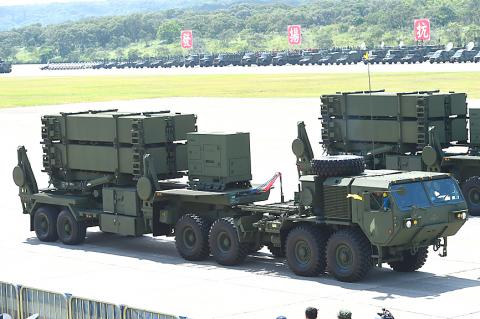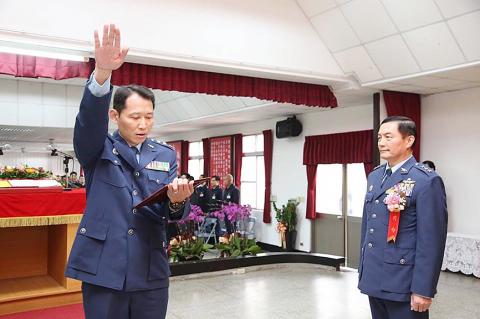The Ministry of National Defense said Patriot Advanced Capability-3 (PAC-3) missile batteries have been deployed on the east coast in response to an increased Chinese military presence in the area.
To improve integrated air defense capabilities, the ministry has deployed missiles to Hualien and Taitung counties, and merged the Air Defense Missile Command with the air force to streamline the chain of command, a ministry report submitted to the Legislative Yuan said.
The reorganization and relocation was ordered after the Chinese People’s Liberation Army (PLA) conducted several long-distance naval and aviation training missions — featuring an aircraft carrier and fleets of nuclear-capable bombers — in the East China Sea, South China Sea, East Indian Ocean and western Pacific Ocean to demonstrate its long-range power projection capabilities and Beijing’s ambition to dominate the Asia-Pacific region.

Photo: Chang Chia-ming, Taipei Times
Annual military exercises would test the effectiveness of the deployments, the ministry said.
It is the first time the ministry has confirmed the deployments, after speculation emerged following the publication of photographs last month showing missiles in the military’s air defense bases in eastern Taiwan.
The report also announced a doctrinal shift from “effective deterrence” to “multiple deterrence.”

Photo: Military News Agency
The ministry said that it would develop the defense industry to ensure self-sufficiency and national security.
A quadrennial defense review, along with three defense plans that are expected to be the guidelines for the nation’s military buildup, are to be submitted to the Legislative Yuan by March 19.
The military is to conduct new exercises, including integrated air-and-sea training, rescue missions, fishing boat escort missions and supply missions in response to the PLA’s actions.
In addition to field exercises, computer-aided simulations are to be part of regular armed forces exercises.
A tactical engagement simulation system has been built for the army, and the ministry is exploring creating new simulation systems using virtual and augmented-reality technologies.
Measures have been taken to improve the military’s digital warfare capabilities this year, with Academia Sinica and the National Chungshan Institute of Science and Technology forming partnerships with the military, the ministry added.
The Air Defense Missile Command was yesterday merged with the air force at a handover ceremony at the command’s Taishan District (泰山) headquarters in New Taipei City.
The command, to be headed by Colonel Yu Jen-ming (游仁明), is expected to merge with the Air Defense Artillery Command to improve operational efficiency.
“The missile command is a high-tech, combat-ready unit and it is one of the most important components of the integrated air defense system,” Air Force Commander General Shen Yi-ming (沈一鳴) said.
The merger would see the transfer of PAC-3, Tien Kung anti-ballistic missiles and Hawk anti-aircraft missiles, as well as tactical counterstrike missiles and Hsiung Feng 2E cruise missiles, to the air force.

The US government has signed defense cooperation agreements with Japan and the Philippines to boost the deterrence capabilities of countries in the first island chain, a report by the National Security Bureau (NSB) showed. The main countries on the first island chain include the two nations and Taiwan. The bureau is to present the report at a meeting of the legislature’s Foreign Affairs and National Defense Committee tomorrow. The US military has deployed Typhon missile systems to Japan’s Yamaguchi Prefecture and Zambales province in the Philippines during their joint military exercises. It has also installed NMESIS anti-ship systems in Japan’s Okinawa

‘WIN-WIN’: The Philippines, and central and eastern European countries are important potential drone cooperation partners, Minister of Foreign Affairs Lin Chia-lung said Minister of Foreign Affairs Lin Chia-lung (林佳龍) in an interview published yesterday confirmed that there are joint ventures between Taiwan and Poland in the drone industry. Lin made the remark in an exclusive interview with the Chinese-language Liberty Times (the Taipei Times’ sister paper). The government-backed Taiwan Excellence Drone International Business Opportunities Alliance and the Polish Chamber of Unmanned Systems on Wednesday last week signed a memorandum of understanding in Poland to develop a “non-China” supply chain for drones and work together on key technologies. Asked if Taiwan prioritized Poland among central and eastern European countries in drone collaboration, Lin

Renewed border fighting between Thailand and Cambodia showed no signs of abating yesterday, leaving hundreds of thousands of displaced people in both countries living in strained conditions as more flooded into temporary shelters. Reporters on the Thai side of the border heard sounds of outgoing, indirect fire yesterday. About 400,000 people have been evacuated from affected areas in Thailand and about 700 schools closed while fighting was ongoing in four border provinces, said Thai Rear Admiral Surasant Kongsiri, a spokesman for the military. Cambodia evacuated more than 127,000 villagers and closed hundreds of schools, the Thai Ministry of Defense said. Thailand’s military announced that

CABINET APPROVAL: People seeking assisted reproduction must be assessed to determine whether they would be adequate parents, the planned changes say Proposed amendments to the Assisted Reproduction Act (人工生殖法) advanced yesterday by the Executive Yuan would grant married lesbian couples and single women access to legal assisted reproductive services. The proposed revisions are “based on the fundamental principle of respecting women’s reproductive autonomy,” Cabinet spokesperson Michelle Lee (李慧芝) quoted Vice Premier Cheng Li-chiun (鄭麗君), who presided over a Cabinet meeting earlier yesterday, as saying at the briefing. The draft amendment would be submitted to the legislature for review. The Ministry of Health and Welfare, which proposed the amendments, said that experts on children’s rights, gender equality, law and medicine attended cross-disciplinary meetings, adding that